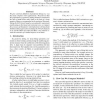Free Online Productivity Tools
i2Speak
i2Symbol
i2OCR
iTex2Img
iWeb2Print
iWeb2Shot
i2Type
iPdf2Split
iPdf2Merge
i2Bopomofo
i2Arabic
i2Style
i2Image
i2PDF
iLatex2Rtf
Sci2ools
3DIM
2005
IEEE
2005
IEEE
Further Improving Geometric Fitting
We give a formal definition of geometric fitting in a way that suits computer vision applications. We point out that the performance of geometric fitting should be evaluated in the limit of small noise rather than in the limit of a large number of data as recommended in the statistical literature. Taking the KCR lower bound as an optimality requirement and focusing on the linearized constraint case, we compare the accuracy of Kanatani’s renormalization with maximum likelihood (ML) approaches including the FNS of Chojnacki et al. and the HEIV of Leedan and Meer. Our analysis reveals the existence of a method superior to all these.
| Added | 13 Oct 2010 |
| Updated | 13 Oct 2010 |
| Type | Conference |
| Year | 2005 |
| Where | 3DIM |
| Authors | Ken-ichi Kanatani |
Comments (0)

